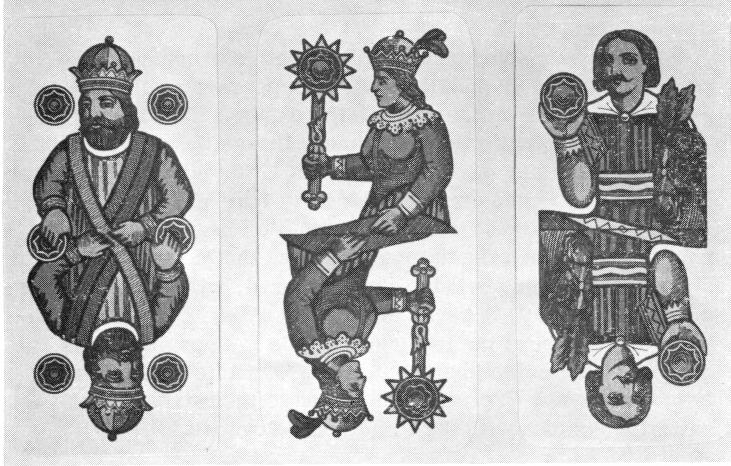

| Suit System: | IT |
| Recommended Name: | the Tarocco Bolognese. |
This pattern was originally classified as IT-2.
Properly called the Tarocco Bolognese. The name Tarocchino is no longer in use
among players, and begs the question whether the pattern was from the start used
for a shortened pack.
This pattern is probably the oldest still in use, and has the most undeviating history. Its use has always been confined to Bologna and its immediate environs. Two sheets from the same pack, one in the Rothschild Collection at the Louvre and one in the École des Beaux Arts in Paris, show it in existence at the end of the 15th century: the only card on these sheets whose design was later changed is the Devil. The pack was the first Tarot pack to go double-headed (in the second half of the 18th century), and the last to introduce numerals for the trumps, which it did at about the same time.
The pack is a shortened one, lacking, in every suit, the numeral cards 2-5, making a 62-card pack: this shortening probably dates from the early 16th century. The trump subjects were originally the usual ones, though the order is not the same as in any other pack: but in 1725 the Pope, Emperor, Empress and Popess were replaced by four Moors. The Moors and the lowest trump (Bagattino or Begato) are never numbered; nor are the top four trumps, the Moon, Sun, World and Angel. The remainder are numbered, with Arabic numerals, from 5 to 16, in packs after about 1760. In the 17th century, the lowest of the four court cards in Cups and Coins were female (maids instead of jacks), but this practice was later abandoned. For cards common to the two packs, the pattern coincides with the Primiera Bolognese.
"Al Mondo" (18th century), "Al Cigno" or Germano Natali (early 19th century), Emilia Angiolini (19th century), Alessandro Grandi (c.1862), Carlo Provasi (c.1870), all of Bologna.
P. Cassini, Ferrara (c.1800).
G. Murari, Bari (c.1910).
Viassone, Turin (early 20th century).
Modiano and Cambissa, both of Trieste (20th century).
Dal Negro, Treviso (20th century).
Beghi (first half of 20th century) and Plastic Cards (1974), both of Milan.



| Top row: "Al Soldato", showing the style of early cards, including the maid of Cups; bottom three rows: Modiano of Trieste, modern double-headed pack. |
| The International Playing-Card Society | August, 1978 |